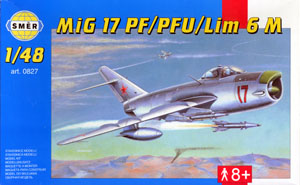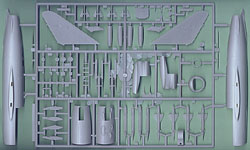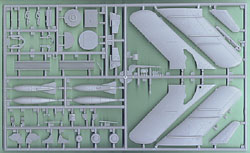


 Smer's
1/48
Smer's
1/48
MiG-17PF/PFU/Lim-6M
By Michael Benolkin
History
The MiG-17 was a development from the MiG-15 fighter of the Korean War. By changing the engine and adjusting the wings a bit, the MiG-17 built upon all the good features of the MiG-15 and became a potent fighter. The PF version went a step further and added even more capabilities by including a radar set. This allowed the MiG-17 to find targets in adverse weather and at night, giving this plane true 24-hour capabilities.
The MiG-17 was built in Poland as well, and the PF variant was built under the name of Lim-6M. The MiG-17 family went on to serve in the air forces of dozens of countries around the world and can still be found flying in some of the smaller countries out there. Not a bad life for a plane designed in the late 1940s.
 The
Kit
The
Kit
The Smer kit of the MiG-17PF is molded in a light gray plastic with their typical pebbly texture. The recessed panel lines are very well done and will look outstanding once under a coat of paint. The breakdown of the parts lend themselves well to other MiG-17 variants, with a separate vertical tail, separate nose intake lip, and separate nose undersides. A comprehensive decal sheet gives a total of four choices.
Starting with the interior, there is a lot there to look good. The instrument
panel and side wall panels are provided as decals designed to fit behind
clear injection pieces so all that will be needed is some careful painting
around the instrument faces. The tub itself is made up of a separate floor,
a 9-piece ejection seat, separate sidewalls and a front and rear bulkhead.
This assembly then fits onto the nose wheel well assembly,  which
has space inside for nose weight. This is good, because this model will
definitely be a taildragger without it. A long tailpipe with a separate
bulkhead and exhaust petals fill the rear hole in the fuselage.
which
has space inside for nose weight. This is good, because this model will
definitely be a taildragger without it. A long tailpipe with a separate
bulkhead and exhaust petals fill the rear hole in the fuselage.
The separate nose undersides for the PFU and the PF/Lim-6M variants will likely be a trouble spot in terms of fit, but if you take care and do several dry runs the potential for problems should be minimized. The cannon barrels on this kit are provided as plastic pieces, but this is one model that would really benefit from replacing them with steel tubing.
The wings and vertical tail are split in halves and due to the injection process will end up having rather thick trailing edges. Some careful work with the sandpaper can rectify this, though. One very nice touch of this kit is the underwing stores. you get two drop tanks, four missiles (for the PFU variant) and two rocket pods (for the Lim-6 variant). Those that aren't used will be very useful in the spares box.
 The
canopy has a lot of detail molded into it and can be displayed either
open or closed. Other clear parts include the fuselage underside clear
panels, gunsight, wingtip lights, and fuselage lights. Including the lights
is a very nice touch, although the small size of the parts will make it
difficult to apply them without damaging them.
The
canopy has a lot of detail molded into it and can be displayed either
open or closed. Other clear parts include the fuselage underside clear
panels, gunsight, wingtip lights, and fuselage lights. Including the lights
is a very nice touch, although the small size of the parts will make it
difficult to apply them without damaging them.
The decals are simply beautiful. Printed by Propagteam, they are thin and in perfect register. A total of four choices are included; two in natural metal finish and two camouflaged. The first natural metal option is the boxtop example, a MiG-17PFU, in Soviet markings. Instead of including this example in the instructions, Smer printed a four-view layout of this one on the bottom of the box, showing where all the various markings go.
 The
second natural metal example is a Czech bird, this time a MiG-17PF. Like
the Soviet example, this one is a simple layout consisting of little more
than roundels and a number. For a more exciting paint scheme, you'll have
to turn to the other two options: the Polish and the Egyptian ones.
The
second natural metal example is a Czech bird, this time a MiG-17PF. Like
the Soviet example, this one is a simple layout consisting of little more
than roundels and a number. For a more exciting paint scheme, you'll have
to turn to the other two options: the Polish and the Egyptian ones.
The Egyptian MiG-17PF is painted in dark brown and yellow sand over blue, with the Egyptian roundels in six positions and a red bat on the nose. The Polish example is a Lim-6M and is painted up in dark green and yellow sand over blue and carries the Polish markings in six positions plus on the vertical tail. All of these last three schemes are printed on the box side in color, giving a good idea as to how they'll look when done.
Conclusion
This is a very well done model of the MiG-17PF and while it may not be up to the standards set by such companies as Tamiya or Hasegawa, it is definitely buildable and sufficiently detailed to need little else out of the box. If you've been wanting to add an all-weather MiG-17 to your shelves, this is the kit for you.

Previous: Contents







